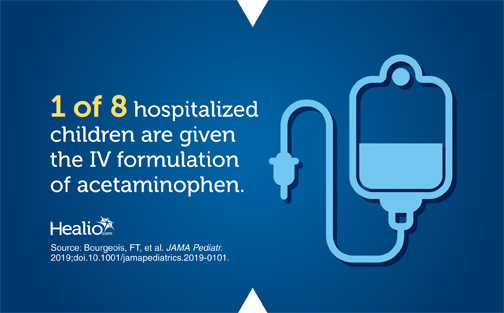IV acetaminophen use raises costs in pediatric hospitals

The costs for total acetaminophen use in hospitalized children rose significantly since the introduction of IV acetaminophen, according to study results published in JAMA Pediatrics.
“Acetaminophen is one of the most commonly administered medications in children, and physicians need to be aware of the high costs associated with the newer intravenous formulation,” Florence T. Bourgeois, MD, MPH, associate professor of pediatrics at Harvard Medical School and director of the Pediatric Therapeutics and Regulatory Science Initiative at Boston Children’s Hospital, told Infectious Diseases in Children.
The FDA approved the IV formulation of acetaminophen in 2011, and it is currently administered in about one of eight pediatric hospitalizations.
To examine the use of the new formulation since its introduction and the cost of acetaminophen among hospitalized children, Bourgeois and colleagues used data from Pediatric Health Information System database. The researchers focused on 34 U.S. hospitals that had complete data between 2010 and 2017.
The researchers calculated that 2,173,688 (48%) pediatric hospitalizations included some use of acetaminophen.

They wrote that oral acetaminophen use remained stable over the study period, being used in a yearly mean of 41% of hospitalizations (mean change per year, 0.04%). Oral acetaminophen use was associated with mean yearly costs of $2.2 million. Rectal acetaminophen use dropped from 8% to 5% (mean change per year, –0.5%) and was associated with mean yearly costs of $226,876. However, IV acetaminophen use increased to 13% in 2017 (mean change per year, 2%), comprising 20% of hospital days with any acetaminophen use and reaching $16 million in costs that year.
The researchers reported that 61% of hospital days with IV acetaminophen were associated with the use of an oral drug other than acetaminophen. They said there was an increase in total costs for acetaminophen use among hospitalized children — from $2.7 million in 2010 to $18.1 million in 2017.
The researchers noted that “while the new formulation has been marketed as an alternative to opioids in managing perioperative pain, pediatric surgical patients receiving intravenous acetaminophen have not experienced reductions in opioid consumption or opioid-related adverse events.”
Bourgeois said that in an effort to contain costs yet still ensure the appropriate use of IV acetaminophen, “health care facilities should consider implementing evidence-based guidelines.” – by Bruce Thiel
Disclosures: Bourgeois reports no relevant financial disclosures. Please see the study for all other authors’ relevant financial disclosures.
